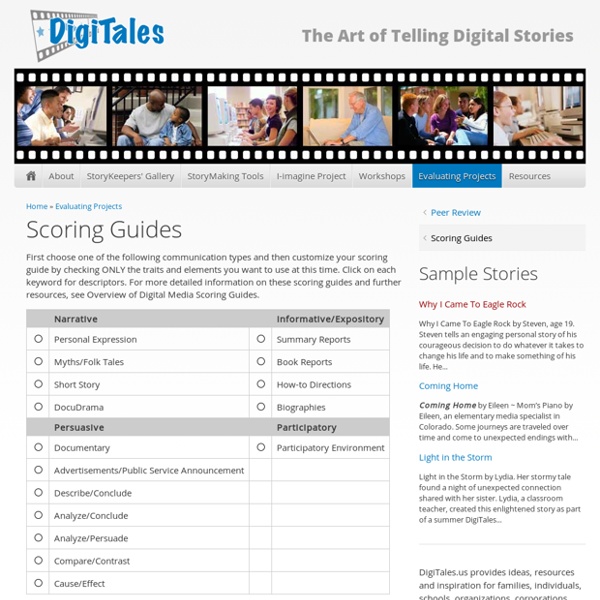



http://digitales.us/evaluating-projects/scoring-guides
Rubrics for Assessment Learn more about our Online Courses, Online Certificate Programs, and Graduate Degree A collection of rubrics for assessing portfolios, group work/cooperative learning, concept map, research process/ report, PowerPoint, oral presentation, web page, blog, wiki, and other social media projects. Quick Links to Rubrics 21st Century skills This is the second article of a three-part Business English series by ELT teacher, teacher trainer and course book author, John Hughes. Here, he looks at how the use of video can support business English teaching. One survey into the use of video in education reports that teachers increasingly welcome this tool as a means to support learning.
Discover the world's most endangered species Wildscreen's Arkive project was launched in 2003 and grew to become the world's biggest encyclopaedia of life on Earth. With the help of over 7,000 of the world’s best wildlife filmmakers and photographers, conservationists and scientists, Arkive.org featured multi-media fact-files for more than 16,000 endangered species. Freely accessible to everyone, over half a million people every month, from over 200 countries, used Arkive to learn and discover the wonders of the natural world. Since 2013 Wildscreen was unable to raise sufficient funds from trusts, foundations, corporates and individual donors to support the year-round costs of keeping Arkive online. Welcome To Mixed Reality 2015 is going to be remembered as the year we entered an entirely new world, a world today known as Mixed Reality. What is Mixed Reality? In short, Mixed Reality is the world which we now inhabit where real and virtual objects co-exist and can causally influence each other.
How to Create Your Own Textbook — With or Without Apple By Dolores Gende Apple’s iBooks2 and authoring app has created big waves in education circles. But smart educators don’t necessarily need Apple’s slick devices and software to create their own books. How educators think of content curation in the classroom is enough to change their reliance on print textbooks. As the open education movement continues to grow and become an even more rich trove of resources, teachers can use the content to make their own interactive textbooks.
Maths Centre Choose from over 80 mathematical videos. Our team of top teacher mathematicians have put together all the important topics and explain them with the types of examples that you would find in a normal textbook or exam. Page 1 | 2 | 3 | 4 | 5 | 6 | 7 | 8 | 9 a cos x + b sin x = R cos(x - a) a cos x + b sin x = R cos(x - a) . Great Websites for Kids Selection Criteria Established by the first ALSC Children and Technology Committee, 1997; revised by the ALSC Great Websites Committee/revisions approved by the ALSC Board of Directors, 2013 Introduction: The Web is a lot like a flea market: there’s a vast selection of sites to choose from but not a lot of order to it. Some sites are offered by reputable “dealers” and some from individuals who want to show off their personal favorite items.
A New Way For Students To Share Notes & Learn Together For students with disabilities, some colleges and universities offer a note-taking service that includes collecting notes from the professor, a teaching assistant, or a fellow student. There are other students that might need to review classmates’ notes, however. A student athlete with an injury A student that wants to improve his note-taking skills and could use a model to follow Study group members that need a central repository for notes and a way to merge those notes together. Whatever the reason, Studyers.com , a website that claims to be “the easiest way to take notes on lessons,” wants to be their cloud-based alternative to the traditional notebook. The site is currently in the alpha stage, so access is restricted at this time. Once the site is public, however, users will sign in to a clean, simple interface.
2012 Kavli Contest Themes Join hundreds of the world’s leading scientists, engineers, thinkers, and innovators as we tackle mankind’s greatest challenges and help to build our future. Our contest theme this year was inspired by the National Academy of Engineering (NAE) Grand Challenges. "Meeting these challenges would be 'game changing,'" says NAE president Charles M. Teachers TV - The Department for Education Skip to main content GOV.UK uses cookies to make the site simpler. Find out more about cookies Is this page useful? Yes this page is useful No this page is not useful Is there anything wrong with this page? Thank you for your feedback DebateGraph DebateGraph is an award-winning, web-platform for visualizing and sharing networks of thought – and opening reasoning and action to collaborative learning and iterative improvement.Create your own maps and explore and contribute to maps created by amongst others: CNN, the White House, the UK Prime Minister's Office, The Independent, and the Foreign Office. DebateGraph is being used in over 100 countries and helping people reason and learn together more effectively in many different fields, including: education, health, governance, media, publishing, environment, conflict resolution, conferences, group facilitation, and public consultation and planning.There's no limit to the number of people who can collaborate on maps, and you are welcome to start building and sharing public and private maps on any topic now. Copyright © 2014 Thoughtgraph Ltd.